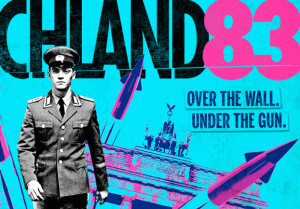 Tonight a new television series premieres on the Sundance Network, Deutschland 83. My cable package doesn’t include Sundance, so I won’t be able to watch the show in its first run, but so far I like what I’ve read about it. More than that, it’s exciting to read about its premise and development, as much of it reminds me of the impetuses that drove me to write Edward Teller Dreams of Barbecuing People.
Tonight a new television series premieres on the Sundance Network, Deutschland 83. My cable package doesn’t include Sundance, so I won’t be able to watch the show in its first run, but so far I like what I’ve read about it. More than that, it’s exciting to read about its premise and development, as much of it reminds me of the impetuses that drove me to write Edward Teller Dreams of Barbecuing People.
The Cold War
Deutschland 83 and Edward Teller Dreams are both Cold War stories featuring individuals caught on the front line of a war that had no front lines. For Deutschland 83, the main character is Martin Rauch, an East German Stasi officer sent to West Germany under cover. For Edward Teller Dreams, teenager Gene Harland is the son of a nuclear physicist tasked to develop the Strategic Defense Initiative (SDI), a pie-in-the-sky system to deter nuclear attack immediately dubbed “Star Wars” by its critics.
It can’t be overstated how permanent the Cold War appeared in 1983. The idea that in six short years the Berlin Wall would fall, taking with it the Soviet Union and much of the Eastern Bloc, was so unthinkable it wasn’t even contemplated by science fiction or Hollywood. They preferred to traffic in darker visions of Soviet domination, films such as Red Dawn, the Russians’ technological superiority in The Hunt for Red October, and 1983’s nuclear-scare TV sensation The Day After. Even MTV got into the act: 1983’s pop hit “99 Luftballons” was about toy balloons starting World War III. Every Child of the 80s remembers Reagan and Chernenko boxing it out in Frankie Goes to Hollywood’s 1983 video for “Two Tribes”.
With each passing year of nuclear stalemate, the saber-rattling rhetoric, and the occasional act of aggression that had to be negotiated down, the Cold War increasingly looked like Orwell’s vision of perpetual war. Of course, that comparison suggests the Cold War was ginned up to control populations rather than being a legitimate stand-in for irreconcilable differences between nations. Personally, I think it was a bit of both.
The birth of the modern era
I was also surprised to read that Deutschland 83 is set in “1983, the birth of the modern era”. Although I chose 1983 for Edward Teller Dreams because it coordinated with the year SDI’s development started, in earlier revisions I dabbled with setting the novel later in time, in 1984 or even 1985. The more I researched 1983, I realized I had to set my novel in that year and none other. (I’ll discuss more about this in a future post.)

Retailing in 1983 for $9,995 ($24,000 in 2015 dollars), the Apple Lisa mysteriously failed to capture the public’s imagination.
The developments in 1983 belie the stereotype of the Reagan years as drab, conservative, and conformist. In hindsight, the 1980s were remarkably dynamic, with 1983 perhaps the most so. SDI, Apple’s Lisa (the first personal computer sold with a graphic display and a mouse), the first reports of the AIDS virus and the solidifying of the gay rights movement, even the birth of the Internet on January 1st (the story’s more complicated than that, but roll with it). 1983 was more than an eventful year, it was a prescient year.
(And it was a great time to be alive if you were a reader: The Mists of Avalon, The Robots of Dawn, John Le Carre’s Little Drummer Girl, and Walter Tevis’ The Queen’s Gambit were all published in 1983. The Color Purple was published the year before. William Gibson’s Neuromancer would be published in 1984, following six productive years of groundbreaking science fiction short stories.)
Even in the context of the Cold War, 1983 may have been more consequential than 1962, the year of the Cuban Missile Crisis. In March 1983, Reagan declared the Soviet Union to be an “evil empire” and authorized the development of SDI, “a shield, not a sword”. In August the Soviet Union shot down civilian jetliner Korean Air Flight 007 and ignited an international uproar. All of this, as well as forty years of East vs. West posturing, culminated in the Soviet Union almost launching all-out nuclear war in November when it misread an American troop exercise as first-strike preparations. This series of “isolated” events—microaggressions on the macro scale— were not easily contained via formal diplomatic channels. They were exactly the type of unchecked escalation feared the most during the Cold War.
Writing into near-history
Publishers ask you to list two or three genres to help categorize your novel. While every author feels their novel transcends such pedantic pigeonholing—only partial sarcasm there—I’ve usually selected “historical fiction” for Edward Teller Dreams. It’s a problematic label, however, and not because I’m being snooty.
 The term “historical fiction” evokes costume drama and so-called simpler times of clear-cut morality and rigid social standings. Most historical fiction book review web sites will only consider work that’s set at least fifty, seventy-five, even a hundred years in the past. Edward Teller Dreams is set thirty-two years ago (and was less than twenty years in the past when I first started writing it). Even with all I’ve described above, it’s hard to say the world has changed that much. I readily admit there’s more similarities between 1983 and 2015 than there are differences.
The term “historical fiction” evokes costume drama and so-called simpler times of clear-cut morality and rigid social standings. Most historical fiction book review web sites will only consider work that’s set at least fifty, seventy-five, even a hundred years in the past. Edward Teller Dreams is set thirty-two years ago (and was less than twenty years in the past when I first started writing it). Even with all I’ve described above, it’s hard to say the world has changed that much. I readily admit there’s more similarities between 1983 and 2015 than there are differences.
But even in writing this one novel I uncovered a number of obstacles with setting a story in near-history. I suspect the writers of Deutschland 83 faced them as well. Show creator Anna Winger says “The great privilege is it’s living history. People are still around and they want to talk about it.” I would say this privilege also nods towards its challenges.
In interviews with authors who pen historical fiction, there’s much discussion about research, authenticity, understanding the period, understanding moires and daily language, and so forth. Some historical fiction authors even go so far to dress in period clothing to better understand their subjects. Me? I threw on a T-shirt and a pair of corduroy jeans and—voila—welcome to exotic California, 1983.
But I’ll go to go out on a limb and say writing near-history is equally challenging to writing “real” historical fiction, and maybe more so. Ask someone what they think of the 1880s and you’ll receive silence, or maybe “I don’t know, why do you ask?” Ask someone what they think of the 1980s and you’ll get an earful. To retell near-history, you’re confronting people’s personal memories as well as the collective memory of our recorded culture.
I don’t think Edward Teller Dreams is a bold stab at righting some historical wrong, or a rewriting of the past to spotlight silenced voices. It doesn’t sound like Deutschland 83 is out to serve historical justice either. I do feel there are many stories of that era—of every era—that, if taken at face-value and told in good faith, will alter our understanding of history as well as our present. To retell stories from the 1880s is fine, but to retell the state of the world of the 1980s is to challenge our perception of the world today.